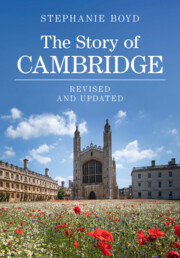Book contents
- The Story of Cambridge
- Dedication
- The Story of Cambridge
- Copyright page
- Contents
- Cambridge: a Famous City
- 1 Prehistoric Cam Valley
- 2 Invaders and Settlers
- 3 Medieval Cambridge
- 4 Tudor Cambridge
- 5 The Seventeenth and Eighteenth Centuries
- 6 Victorian and Edwardian Cambridge
- 7 Cambridge at War
- 8 The Modern City
- Acknowledgements
- Index
- The Story of Cambridge
- Dedication
- The Story of Cambridge
- Copyright page
- Contents
- Cambridge: a Famous City
- 1 Prehistoric Cam Valley
- 2 Invaders and Settlers
- 3 Medieval Cambridge
- 4 Tudor Cambridge
- 5 The Seventeenth and Eighteenth Centuries
- 6 Victorian and Edwardian Cambridge
- 7 Cambridge at War
- 8 The Modern City
- Acknowledgements
- Index
Summary
In this final section, the author looks at how the skyline of Cambridge has been transformed as new areas such as the Cambridge Biomedical Campus have sprung up. During the twentieth and early twenty-first century, the city has expanded rapidly in size, population and wealth as it has gained a world-class reputation in science, technology and innovation. The author examines the achievements of scientists in the field of molecular biology, including Crick and Watson’s discovery of the structure of DNA, and Fred Sanger’s role in the Human Genome Project. She also considers the forging of links between University and industry, the emergence of the Cambridge Science Park, hi-tech success stories such as ARM, and the forerunners of the hi-tech boom, including Pye, Acorn and Sinclair. Student life in the University today and the iconic Boat Race, Bumps, May Balls and Footlights are clearly explained. Issues affecting the town include the growth of car ownership, the importance of tourism, the development of Lion Yard and the Grand Arcade, and the origins of Petty Cury. At its core, Cambridge remains recognisably medieval, centred on the town and university church of Great St Mary’s.
Keywords
- Type
- Chapter
- Information
- The Story of Cambridge , pp. 156 - 187Publisher: Cambridge University PressPrint publication year: 2023

